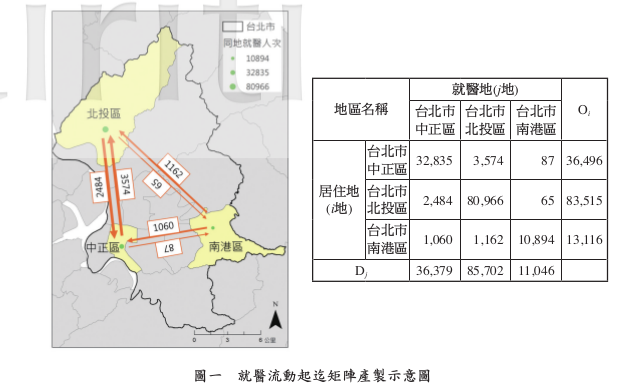
Paper
林民浩,郭年真,陳威全,溫在弘 (2016). 剖析台灣民眾的就醫流動:利用引力模式評估就醫距離與醫療資源分布的影響。, 台灣衛誌. 35(2): 136-151.
Abstract
目標:過去研究多以行政區或醫療分區的每萬人口醫療資源數作為評估就醫可近性之指標,但分區的概念簡化民眾就醫行為,與實際醫療利用情形有所落差。本研究將以實際就醫流動資料呈現各地區醫療可近性,並量化就醫距離與醫療資源分布對就醫流動的影響。方法:使用全民健康保險研究資料庫2010年承保抽樣歸人檔,依居住地與就醫地建立流動起迄矩陣,計算各鄉鎮市區加權就醫距離作為可近性指標,再以引力模式估計影響就醫流動的因素。結果:加權就醫距離呈現出花東與雲嘉沿海等地有較差的醫療可近性。引力模式分析顯示,就醫距離與醫療資源皆顯著影響民眾的就醫流動。然而,相較於急診與住院的就醫流動,就醫距離對於門診就醫流動影響更為明顯。但於鄰近地區的就醫權衡,醫療機構一般病床數對於急診與住院就醫流動的吸引力,更重於就醫距離的效果。結論:加權就醫距離更能客觀反映一地醫療可近性。求近是台灣民眾就醫的首要考量,但民眾急診與住院就醫,則傾向在鄰近地區中尋求硬體規模最大者。
English info
Lin, M. H., Kuo, R. N., Chin, W. C. B., & Wen, T. H. (2016). Profiling the patient flow for seeking healthcare in Taiwan: using gravity modeling to investigate the influences of travel distance and healthcare resources (in chinese). Taiwan Journal of Public Health 35(2): 136-151.
Abstract
Objectives: Township-level physician-to-population and hospital bed-to-population ratios have been widely adopted as indicators of health care accessibility in Taiwan; however, these indicators cannot reflect actual healthcare-seeking behaviors of patients. Therefore, the aims of this study were to establish actual patient flow for seeking healthcare and to clarify the factors influencing preferences for seeking healthcare. Methods: We estimated the residence and collected the locations of healthcare visits for each patient from the nationwide Longitudinal Health Insurance Database in 2010 to establish an origin-destination matrix. The patient flow among townships could be conducted from the matrix. The weighted travel distance of healthcare visits was developed as a new indicator of accessibility. The gravity model was then used to analyze the patient flow and assess the influences of travel distance and healthcare resources. Results: Using the weighted travel distance, eastern Taiwan and the coastal areas of Yunlin and Chiayi were identified as the poorest accessibility for healthcare resources. The results of the gravity model showed that travel distance was the major factor correlated negatively with the volumes of outpatient and inpatient/emergency flow; however, the abundance of healthcare resources positively influenced the preference of inpatient/emergency patients from their residence to neighborhood regions for seeking healthcare. Conclusions: The weighted travel distance could properly reflect the access of healthcare. We conclude that travel distance is the major factor which influences patient flow for seeking healthcare. In contrast, people tend to choose the healthcare facilities with abundant resources for seeking inpatient/emergency healthcare.
Read article here:
- Official website: 剖析台灣民眾的就醫流動:利用引力模式評估就醫距離與醫療資源分布的影響。, 台灣衛誌,
- ResearchGate: Abstract and full text (on request or downloadable directly),
- Please contact me (by Gmail ).
